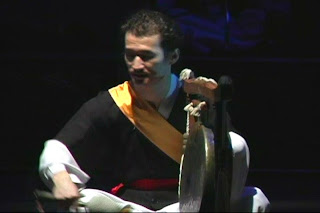And this means a few things:
1. Everybody travels to their ancestral home to honour the ancestors.
2. For anybody who STAYS in Seoul (because everybody's either heading for the countryside or taking advantage of the five day vacation, it's impossible to book tickets to travel), there are tons of festivals, cultural demonstrations and performances to see.
 This is called Samulnori. It was popular with farmers coming in from the field. It's noisy and fun. The guy on the far left leads it, it's mostly improvisational, but the clip below gives you a feeling for how it gathers speed as the players go.
This is called Samulnori. It was popular with farmers coming in from the field. It's noisy and fun. The guy on the far left leads it, it's mostly improvisational, but the clip below gives you a feeling for how it gathers speed as the players go. It's hugely thrilling to see in person -- wish you could experience it.
It's hugely thrilling to see in person -- wish you could experience it.A good performance will go eight or ten minutes sometimes, changing tempos and gathering momentum, trading solos and getting noisier and noisier. It's like riding a galloping horse. By the end, all the drummers in our show were dripping with sweat, their heads were bobbing and hair flying everywhere. (Wet hair)

Here's a clip of Kim Duk Soo, a Sameulnori legend, as his performance (somewhat bigger than the usual combo size) reaches its climax. Imagine being there to see this live, close enough to see the whites of their eyes.
Some female dancers came out, and did some lovely fan dances (buchae-chum) that involved spinning and puffing their traditional hanbok out in all directions, just like little girls wearing new dresses.




This is called Pansori, the traditional storytelling form. It has been recognized by UNESCO as an intangible cultural treasure. These Pansori singers are extremely highly trained -- their voices are amazing, more impressive than opera, I think, because Opera is mostly concerned with getting the purest sound, but a good pansori singer MUST have that worn "I've climbed twelve mountain ranges to tell you this story" melancholy in it. It turns into a folk-song singalong midway, and the woman really lets her voice go in all its gritty glory.
A proper Pansori performance can take six hours -- that takes some stamina. A friend told me once that during their training, Pansori performers must practice their vocal exercises until they cough up blood, and there's a movie (Called Sopyanje) about a famous Pansori singer whose father blinded her so that she would experience the grief necessary to become a truly great Pansori singer. (I'm not sure if it's a true story, but it gives you an idea of what is required to be a great singer.)
One thing I love about Korea is that it's a peasant culture -- the best Korean foods are the simple soups and stews that farmers would eat when they came in from the fields. Samulnori (the drumming) was how those same farmers would let out their stress -- work all day in the rice field? Let's bang things together to feel better! Even in this, Pansori (sometimes called Korean Opera), it's not looking for the cleanest highest note (sorry, Sarah Brightman), but the deepest, saddest groan, that defines the best Pansori singers. This makes it very different from Chinese opera, which is so mannered, refined and exact, in a movie I saw about it (Farewell, My Concubine) there's an argument between a singer and an opera historian about whether he's supposed to take five, or six steps before he starts singing during a certain scene of a certain opera.
At the end of the show, the samulnori people came out again, and did this (Pangeut):
They've tied ribbons to sticks attached to their hats. They were flying all over the stage, and it was awesome, they had the whole crowd clapping along, shouting and hollering with joy.
By the way: here's a fantastic arrangement of Led Zeppelin's "Stairway To Heaven" with traditional Korean instruments. I especially enjoyed the solo: skip to six minutes in.
I don't know why Koreans love to do western pop songs and rock classics on their traditional instruments, but the song I've heard played more often than any other by traditional orchestra is "Let It Be". Too bad: the old folk songs have a stately strength that I really enjoy, but maybe they're worried young people can't enjoy the slow smouldering tempos, so they have to supply them with familiar, classic rock tunes. . . which doesn't actually make sense either, because if they're looking for a YOUNG NEW audience, they ought to be covering Black Eyed Peas and Beyonce.
Here's some of the stately stuff I like. The orchestra I saw was seven piece, with five different instruments, and it was more improvisational -- each player got a few bars of solo, and that kind of performance would have been a more common occurrence than a big-ass gala like this one.
Watch the clips; enjoy the culture where I live.

No comments:
Post a Comment
1. Commenting gives me the right to use your comments however I like, whenever I like.
2. You are responsible for everything you say on the internet, forever.
3. Don't be a jerk.
4. Be thoughtful and respectful, or be really really funny.
Comment moderation is currently on. Be patient, please.